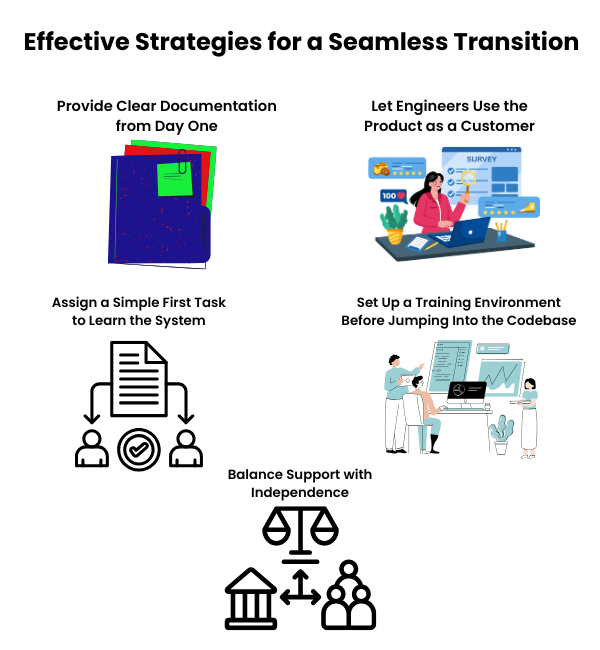Hiring and onboarding new engineers in a fast-growing startup can feel like trying to change a car’s tires while speeding down the highway. One moment, you’re deep in product development; the next, you’re welcoming a new hire, answering endless questions, and making sure they don’t get lost in the complexity of the codebase.
On this episode of the podcast, Ishmael Samuel, co-founder and CTO of Paragon, shared how his team handles onboarding, scaling, and hiring managers while keeping their engineering team productive. He broke down the challenges of adding new hires, the impact on daily operations, and how Paragon is experimenting with new approaches to streamline the process.
From setting up new engineers for success to balancing management responsibilities, Ishmael Samuel gave a behind-the-scenes look at what it takes to build an effective engineering team. Whether you’re a startup founder, an engineering leader, or just curious about how growing companies manage hiring and training, this episode is packed with valuable insights.
The Impact of Hiring on a High-Growth Startup
Hiring in a fast-growing startup isn’t just about filling positions—it’s about keeping the company moving while adding new people without slowing everything down. Every hire brings a mix of fresh energy and growing pains. How do you keep building while onboarding new engineers? How much time should be spent training versus executing? These are the challenges Ishmael Samuel, CTO of Paragon, faces every day.
The Challenges of Scaling Teams Quickly
Hiring takes time—a lot of time. In a fast-moving startup, leaders often find themselves balancing between building the product and building the team. Ishmael pointed out that in high-growth companies, hiring can eat up a third to half of your workweek. The process doesn’t end with signing an offer letter; the real work starts after the new hire joins.
Bringing in new engineers means answering questions, helping them get familiar with the product, and ensuring they don’t feel lost. But too much hand-holding can slow down the team. How do you make sure new hires are supported without pulling too much time from existing projects? That’s where strong onboarding systems come in—something Paragon continues to refine.
Strategic Hiring: Who to Hire and When?
Hiring the right mix of senior and junior engineers can make or break a startup’s growth. Hire too many juniors without guidance, and productivity slows. Bring in too many seniors, and you risk overcomplicating things. Ishmael Samuel shared that for new teams or critical areas, hiring senior engineers first is key. Experienced engineers can pave the way, set up systems, and mentor future hires.
But that’s not always the case. In well-established teams with clear workflows, hiring junior engineers makes sense. They can learn from experienced teammates and grow within the company. Another key decision is specialists vs. generalists. In startups, generalists thrive early on because they can wear multiple hats. As the company scales, specialists become more valuable to refine and optimize specific areas.
Onboarding Engineers: Strategies for a Smooth Transition
Hiring an engineer is one thing—getting them up to speed without slowing the team down is another. A new hire needs to understand the product, the codebase, the workflows, and the expectations before they can start contributing effectively. Without a clear onboarding process, teams get stuck answering the same questions, productivity drops, and new hires feel lost.

At Paragon, Ishmael Samuel and his team have fine-tuned their onboarding process to make transitions smoother and minimize disruptions. Here are five key strategies they use to bring new engineers up to speed efficiently.
1. Provide Clear Documentation from Day One
Instead of answering the same questions over and over, write everything down. New engineers need to know where the code lives, how different systems connect, and how to access tools. Without documentation, onboarding becomes a time-consuming, repetitive cycle.
Paragon makes sure new engineers get access to internal documentation, admin dashboards, and technical resources before they even start working on tasks. The goal? Reduce confusion, increase self-sufficiency, and speed up the onboarding process.
2. Assign a Simple First Task to Learn the System
The worst way to welcome a new hire? Throwing them into a complex project on day one. Instead, Ishmael Samuel and his team carefully pick a “good first issue”—a small, clear task that helps new engineers get familiar with the codebase and workflows without feeling overwhelmed.
These tasks are labeled based on difficulty and category (e.g., front-end, back-end, DevOps), so they align with the new hire’s expertise. The goal isn’t just to get the task done—it’s to help them understand how the system works.
3. Let Engineers Use the Product as a Customer
Before a new engineer touches the code, they need to understand how the product works from a user’s perspective. At Paragon, new hires are asked to create an account, build workflows, and explore the platform just like a customer would.
This hands-on experience helps them see why the product exists, how users interact with it, and what their work will impact. Engineers who understand the product write better code, solve problems faster, and make smarter decisions.
4. Set Up a Training Environment Before Jumping Into the Codebase
Instead of diving straight into the main codebase, new engineers at Paragon start in a separate training repository. This environment mirrors the actual system but is much simpler, allowing new hires to:
- Learn company-specific frameworks and coding conventions.
- Practice writing tests, handling API calls, and following deployment processes.
- Get comfortable with tools without breaking anything.
By mastering the basics in a controlled setup, engineers gain confidence before working on real projects.
5. Balance Support with Independence
A common mistake in onboarding? Too much hand-holding or too little guidance. At Paragon, the approach is simple:
- Engineers should be able to explore and find answers on their own (thanks to documentation and training).
- But when they’re stuck, they should feel comfortable asking for help.
Ishmael Samuel ensures that every new hire has a go-to person for questions and gets regular check-ins. One-on-one meetings help identify blockers, understand challenges, and adjust onboarding as needed.
The Role of Leadership in Managing a Scaling Engineering Team
Hiring and onboarding are just the start. Once a team begins to grow, keeping everything running smoothly becomes the real challenge. Who ensures engineers have what they need? Who removes blockers? How do leaders keep productivity high without micromanaging? These are the questions startup leaders, including Paragon’s CTO Ishmael Samuel, constantly grapple with.
So how do you lead effectively while growing a team? Let’s break it down.
How a CTO Allocates Time for Onboarding and Management
In a startup, leadership means wearing multiple hats—some days you’re deep in problem-solving, and other days you’re hiring, training, or keeping projects moving. Early on, Ishmael Samuel spent much of his time firefighting—jumping in to fix urgent issues and coding alongside the team. But as Paragon grew, he shifted his focus.
Now, his job is removing obstacles, empowering engineers, and keeping projects on track. He jokes that he’s gone from a firefighter to a butler—instead of putting out fires, he makes sure the team has everything they need to do their best work.
But here’s the tricky part: how much time should a leader spend on onboarding versus execution? Ishmael Samuel found that without structure, onboarding can eat into productivity. That’s why he delegates training responsibilities, ensures onboarding is systemized and focuses on high-impact leadership tasks rather than solving every small problem.
One-on-One Meetings: A Key to Engineering Success
No matter how well onboarding is structured, new hires will face challenges. The key is catching problems early before they slow down progress. That’s where one-on-one meetings come in.
- Identifying and Removing Blockers
The most important question Ishmael Samuel asks every engineer: “What’s your biggest blocker?”
This simple question reveals where engineers are stuck—whether it’s a missing tool, unclear documentation, or a slow review process. Identifying these roadblocks helps leaders make smart improvements that increase efficiency for the entire team.
- Building Stronger Team Connections
Startups move fast, and in remote teams, it’s easy for people to feel isolated. Ishmael Samuel makes it a point to connect with engineers beyond just work tasks. Whether it’s discussing personal goals, challenges, or even weekend plans, these conversations help build trust and a strong work culture.
The result? Engineers feel supported, problems get solved faster, and the team stays motivated.
Sprint Planning and Work Allocation
Growth means more projects, more engineers, and more complexity in managing workloads. To keep everything running smoothly, Ishmael Samuel and his team use a structured sprint planning system.
- How Tasks Are Prioritized
Each task is assigned a priority level:
- P0 (Urgent): Needs immediate attention, drop everything else.
- P1 (High Priority): Important but not urgent, should be completed soon.
- P2 (Medium Priority): Necessary but not time-sensitive.
- P3 (Low Priority): Nice to have but might never get done.
Engineers are also assigned tasks based on experience level and workload. For example, senior engineers get more complex issues, while new hires are given simpler tasks to help them get familiar with the system.
- Balancing Workloads to Allow for Training
Onboarding requires time from existing engineers, but that doesn’t mean projects can stall. To manage this, leaders must adjust workload expectations. If a team member is responsible for mentoring, their project load is reduced to make space for it.
Sprint planning isn’t just about assigning work—it’s about making sure engineers have the time and resources to succeed.
What Management Insights Can Be Gained from Scaling Up Hiring in High-Growth Startups?
Scaling up hiring in high-growth startups requires a keen focus on hiring retention strategies. As the team expands, it’s crucial to create a culture that supports employee engagement and satisfaction. Prioritizing these strategies not only helps attract top talent but also reduces turnover, ensuring sustained growth and innovation.
Hiring and Onboarding Engineering Managers

Growing an engineering team is one challenge—finding the right leaders to manage it is another. A startup can’t scale if the CTO is the only one overseeing projects, mentoring engineers, and keeping everything on track. At some point, hiring engineering managers becomes necessary.
But here’s the challenge: who makes a great engineering manager? Should you promote from within or hire externally? How do you onboard a manager who is supposed to lead others? These are the questions Ishmael Samuel and his team at Paragon have been working through as they prepare to bring on their first engineering manager.
So let’s break it down.
The Challenge of Finding Great Engineering Managers
Hiring engineers is hard enough—hiring the right manager is even trickier. Paragon first experimented with promoting engineers into management roles. But as Ishmael Samuel pointed out, not every great engineer wants to be a manager. Some love writing code and solving technical problems, while others thrive in leadership roles.
That’s why Paragon shifted its approach and started looking externally for experienced engineering managers—people who have led teams before and can step in without too much trial and error. At this stage of growth, there’s no time to experiment with leadership.
But finding the right person means looking beyond just technical skills. A great manager needs to:
- Understand engineering—even if they’re not coding daily.
- Communicate effectively—so they can guide and support the team.
- Empower engineers—not micromanage them.
What Makes a Great Engineering Manager?
A great manager isn’t just a boss—they’re a guide. Ishmael Samuel described his leadership style as “pulling from the front” rather than pushing from behind. The best managers take the same approach—removing obstacles, supporting their team, and leading by example.
But here’s where things get tricky. Startups move fast. A new manager has to jump in, understand the culture, and start leading without slowing the team down. Unlike engineers, who can ramp up gradually, a manager needs to be effective almost immediately.
At Paragon, Ishmael Samuel looks for managers who:
- Build relationships with engineers instead of just assigning tasks.
- Balance structure with flexibility—setting up processes without overcomplicating things.
- Know when to step in and when to step back.
Onboarding an Engineering Manager: A Different Process
Bringing in a manager isn’t the same as onboarding an engineer. They don’t just need to learn the codebase—they need to learn the team, the culture, and the expectations. Ishmael Samuel’s approach includes:
- Getting them into one-on-one meetings immediately.
- A new manager needs to quickly understand each engineer’s strengths, challenges, and work style.
- Regular one-on-ones help them build trust and avoid leadership gaps.
- Pairing them with leadership mentors.
- Whether it’s the CTO, another senior leader, or a product manager, new managers need a point of reference to understand expectations.
- Letting them lead a small initiative early on.
- Instead of throwing them into deep strategy work immediately, Paragon assigns new managers a small but meaningful project to see how they lead.
- Encouraging feedback from the team.
- Engineers need to feel comfortable giving feedback about their new manager. Paragon ensures there’s a feedback loop in place.
Final Thoughts: Scaling Teams Without Slowing Down
Hiring and onboarding in a fast-growing startup isn’t just about adding people—it’s about making sure they succeed without disrupting progress. Ishmael Samuel shared how Paragon is refining its onboarding process, leadership structure, and hiring strategy to scale effectively.
From detailed documentation and structured onboarding for engineers to bringing in experienced managers to lead growing teams, every step is designed to keep productivity high while supporting new hires.
As Paragon continues to expand, the focus will remain the same: hiring the right people, setting them up for success, and ensuring leadership evolves alongside the company.
For startups facing similar challenges, the takeaway is clear: Hiring isn’t just about filling roles—it’s about building a system where new employees can thrive without slowing the company down.




